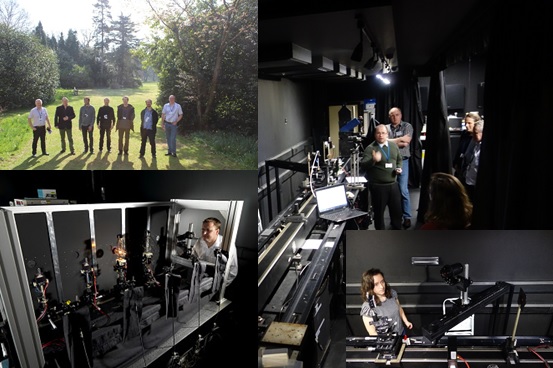Andrew Banks
National Physical Laboratory
April 03-07, 2017
NPL organized an SI-traceable laboratory inter-comparison experiment for ocean colour radiometry reference irradiance & radiance calibration targets (LCE-1) from 3 to 7 April 2017 at NPL headquarters in Teddington, London, UK. This was the first in the series of lab and field intercomparisons aimed at verifying the performance of field Ocean Colour Radiometers (OCR) used for satellite data validation run by the ESA FRM4SOC project (Fiducial Reference Measurements for Satellite Ocean Colour), led by Tartu Observatory and involving ACRI-ST, RBINS (Royal Belgian Institute of Natural Sciences), NPL (National Physical Laboratory), and PML (Plymouth Marine Laboratory).

Representatives of the ocean colour radiometry calibration community in labs and taking a breather outside on LCE-1 in NPL, UK.
Scientists from Europe, North America and Australia spent a very busy week at NPL having their calibration sources measured for comparison as the first part of the European Space Agency (ESA) Fiducial Reference Measurements for Satellite Ocean Colour (FRM4SOC) project. As well as lectures and training in uncertainty budgets, these representatives of the ocean colour radiometry calibration community participated in lab demonstrations of SI-traceable irradiance and radiance calibrations in NPL’s state of the art optics laboratories.
Taking part in the comparisons are some of the world leading organisations in ocean colour, i.e. CSIRO (Australia), DLR (Germany), JRC (the European Commission), LOV (France), NERC (UK), NIVA (Norway), NOAA (USA), and Tartu Observatory (Estonia) with Satlantic (USA/Canada) and Cimel (France) representing the ocean colour radiometer (OCR) manufacturers.
A large part of the Earth Observation Climate and Optical (ECO) Group at NPL contributed to the success of the week with lectures from Dr. Andrew Banks, Ms. Agnieszka Bialek, Dr. Emma Woolliams, and Dr. Teresa Goodman; plus uncertainty training and lab demonstrations from Ms. Agnieszka Bialek, Ms. Claire Greenwell and Mr. Barry Scott. When he wasn’t carrying out the actual FRM4SOC measurements on the Spectral Radiance and Irradiance Primary Scales facility of NPL, Mr. Will Servantes provided a tour of the facility with further ECO tours being provided by Dr. Teresa Goodman for the National Reflectance Reference facility (NRR) and by Mr. Florian Graber for NPL’s primary standard for optical radiation, the cryogenic radiometer.
For the FRM4SOC project, NPL will now move on to conducting a transfer radiometer round robin and then providing an SI-traceable end to end uncertainty evaluation for ocean colour radiometer (OCR) measurements used for validation of satellite ocean colour. This traceability runs all the way from the primary standards at NPL, through the calibration sources, the radiometers themselves and extends towards the use of the OCRs on research vessels or oceanographic towers and buoys. Contact: andrew.banks@npl.co.uk
